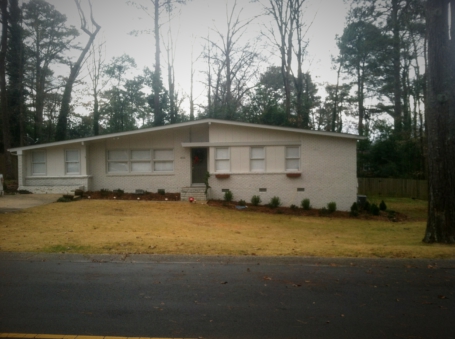 photo courtesy of the homeownerQ: We recently purchased a home that is a 60’s style single-story front gable structure with a low pitched roofline. The interior has been completely remodeled, but I really feel like something needs to be done to the front of the home (entrance) to make it complete. I do realize the roofline will be the most limiting factor, and we may just have to work around it. We really like the Cape Cod/refined look, but don’t know where to start with the ideas to help its curb appeal. Obviously, in the most cost effective way (paint trim, add entrance way, exterior coverings), I was curious to see if you could help us out with a few ideas to bring out the potential in the home.
photo courtesy of the homeownerQ: We recently purchased a home that is a 60’s style single-story front gable structure with a low pitched roofline. The interior has been completely remodeled, but I really feel like something needs to be done to the front of the home (entrance) to make it complete. I do realize the roofline will be the most limiting factor, and we may just have to work around it. We really like the Cape Cod/refined look, but don’t know where to start with the ideas to help its curb appeal. Obviously, in the most cost effective way (paint trim, add entrance way, exterior coverings), I was curious to see if you could help us out with a few ideas to bring out the potential in the home.
Brian of Mountainbrook, AL
A: This rancher front elevation has great unrealized potential. It could really shine if we highlight and capitalize on its inherent ranchiness. That is not to say, however, that a subtle layer of non-ranch influence could not inform its unique countenance. But it would need to be a sympathetic influence, a compatible influence, not something too alien.
stengths and weaknesses
The simple, low-slung, gable roof of this home is probably its most identifying and strongest feature. The next most impactful feature may be the ganged horizontal windows, in what is presumably the living room, to the left of the entrance. The third strongest design element may be the horizontal sills, lintels and entrance canopy. The least successful portion of the front elevation may be the right side of the entrance where three disconcertingly vertical double-hung windows populate the horizontal swath defined by the brick window sill and wood lintel which becomes the entry canopy. Also, it's this side where the base of the home becomes uncomfortably muddled or non-existent. The planter off the far left of the home, in combination with the higher grade there, seem to better ground that side.
new entry porch
The introduction of a more substantial entry porch which extends out from the existing doorway and to the right could help remedy much of what ails the front of this house, while reinforcing the horizontality of the sills, lintels, and canopy, as well as balancing the horizontal bank of living room windows to the left.
I suggest removing the existing entry stoop and replacing it with a grey, rectilinear, stone stoop/terrace that extends to the left a couple of feet and all of the way across the right front and six to eight feet or so forward of that portion of the house. (Of course, this assumes that the local zoning would allow such a stoop/terrace footprint.) The top of the new stone stoop/terrace could run a few inches beneath what appears to be vents along the front. The lower height of the new stoop/terrace would likely mean including a separate landing (of the same material) that's a step or so up in front of the entry door. The new stoop/terrace could end in steps to grade on the far right facing the side yard. The new stoop/terrace would reinforce the home's horizontal design and introduce a base to better ground the home.
A new, deeper, horizontal, wooden canopy in the location of the existing canopy that's supported beneath by thin metal stays/brackets could extend to the left of the door over the new stoop/terrace and to the right across the swath of windows and stop where the existing canopy/lintel stops, while projecting about three and one-half to four feet in front of the right portion of the house. This would provide porch shelter and further reinforce the home's horizontality and the horizontality of the swath that contains the double-hung windows.
new materials and color palette
The introduction of some natural-finish, warm-stained cedar (or fir) might lend the exterior more warmth to play off the painted white brick. In fact, I'd recommend painting the brick another color, something in the light green lichen color family might be pleasant. The existing vertical composite siding above the windows could be replaced with natural-finish, warm-stained vertical cedar v-groove tongue and groove boards. The existing vertical composite siding in between the double-hung windows (both on the right and left sides of the front) could be replaced with natural-finish, warm-stained horizontal clapboards -- again, to reinforce the horizontality of those areas. Window (and door) surrounds in all areas could be replaced with the same natural-finish, warm-stained cedar. Of course, this new palette of materials and colors would need to be applied on all sides of the home. A terrace/landing guard rail composed of new natural-finish, warm-stained intermediate posts, horizontal cable rails, and a natural-finish, warm-stained, shaped cedar cap might complement the new look nicely.
slatted wood screens
You might even consider adding fixed, slatted, natural-finish, warm-stained cedar screens -- the height of the lower double-hung sashes and in alignment with them -- running across the front of the horizontal openings (which contain the double-hung windows and infill to the far left and right of the front door). These would act as privacy screens (instead of the interior window shades) in the more private spaces, while reinforcing the horizontal swaths between the painted brick elements.
enhanced ranchiness infused with an Arts & Crafts touch
The addition of the new horizontal stoop and guard rails, a deeper bracketed horizontal canopy roof, a new materials and color palette, and new slatted wooden screens would enhance this home's ranchiness, while better grounding it and lending it a dash of Arts & Crafts influence (an influence not as far afield from a ranch as a Cape influence).
by Katie Hutchison for House Enthusiast
Email architect Katie Hutchison (Katie@katiehutchison.com) your general-interest residential design question. Put "Ask Katie" in the subject line and summarize your question in a couple of paragraphs. Include your name, town, and state. Check back with the Ask Katie category to look for Katie's responses to select questions.

